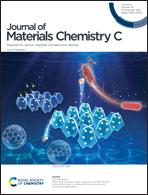Highly self-healable and recyclable graphene nanocomposites composed of a Diels–Alder crosslinking/P3HT nanofibrils dual-network for electromagnetic interference shielding†
Abstract
In this study, a novel self-healing material with a dual-network composed of a cross-linked structure by Diels–Alder (DA) chemistry interconnected with self-assembled π-conjugated polymer nanofibrils was developed for application in electromagnetic interference (EMI) shielding. A poly(caprolactone-co-furfuryl glycidyl ether)-block-hydrogenated polybutadiene-block-poly(caprolactone-co-furfuryl glycidyl ether) copolymer (PCLF–HPB–PCLF) was synthesized and used as the primary molecular skeleton for incorporating graphene nanosheets (GNS). This was followed by the addition of poly(3-hexylthiophene) (P3HT) as the dispersant, which effectively promoted the dispersion of GNS through π–π interactions. Through an aging process, P3HT progressively self-organized into nanofibrils, forming an interpenetrating network that effectively prevented the GNS from restacking. Moreover, 1,1′-(methylenedi-4,1-phenylene)bismaleimide (BMI) was added to the hybrid. Within the multicomponent system, the different diene/dienophile pairs of furan/maleimide, graphene/furan, and graphene/maleimide underwent multiple DA reactions, resulting in a cross-linked structure that was interconnected with the nanofibrillar P3HT network. This dual-network structure facilitated the enhancement of GNS dispersion, thereby improving the uniformity of the internal structure of the material system and endowing it with sufficient plasticity through the triggering of the retro-DA reaction. Specifically, the nanocomposite (containing 5 wt% GNS and 10 wt% P3HT) with a dual-network structure exhibited excellent self-healing and reprocessing abilities. By contrast, the composite (containing 5 wt% GNS) with a single-network structure by DA chemistry exhibited poor self-repairing and remolding properties. In addition, the dual-network hybrid had excellent electrical properties, with a conductivity of 303.6 S m−1 and an EMI shielding effectiveness of 24.4 dB in the X-band frequency range. These results clearly demonstrate the synergistic effect of the self-assembled π-conjugated polymer network in enhancing the dispersion of GNS in a DA cross-linked system. The present findings provide a promising direction for the development of novel multifunctional durable materials, showing potential for future electromagnetic applications.



 Please wait while we load your content...
Please wait while we load your content...